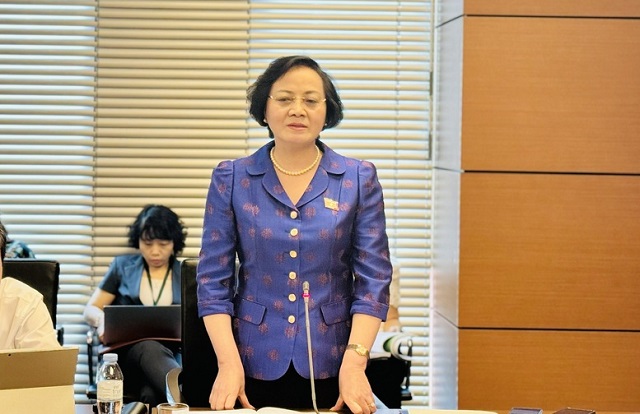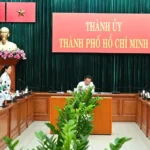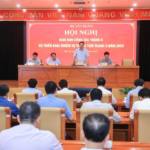
Minister of Home Affairs Pham Thi Thanh Tra speaks at Group 5 – Photo: VGP/Thu Giang
|
On the morning of June 11th, as part of the second working phase of the 9th session, National Assembly delegates discussed the proposal for rearranging administrative units at the provincial level in 2025, following the Government’s presentation and the Law Committee’s review report.
A “comprehensive restructuring”
Speaking at Group 5 (comprising National Assembly members from Yen Bai, Binh Duong, and Quang Nam), Minister of Home Affairs Pham Thi Thanh Tra (from Yen Bai delegation) emphasized that this is a “comprehensive and thorough administrative revolution.”
According to Minister Pham Thi Thanh Tra, rearranging administrative units at the provincial level involves more than just merging geographical boundaries or reorganizing administrative apparatuses; it entails a comprehensive restructuring of territorial space, institutions, culture, economy, and development landscape.
The Minister referred to this as a “comprehensive and thorough revolution,” currently in its “final sprint” stage, marked by urgency and swiftness, as well as meticulousness, thoroughness, and seriousness.
A crucial aspect of this process is the high level of consensus among the entire political system, the people, and society.
The Minister affirmed, “We are moving at a rapid yet certain pace. Each step marks a transformation in the new development space, generating great momentum, faith, and aspirations for the entire nation.”
In her opinion, this could be considered the most significant administrative reform since the country’s establishment. A distinctive feature of this rearrangement is that it takes into account not only geographical, demographic, and natural area factors but also historical, cultural, ethnic, religious, philosophical, and social psychological factors, as thoroughly considered by the Politburo and the Party Central Committee.
Furthermore, this reorganization is linked to the establishment of a two-tier local government model, replacing the current three-tier model. This new model is considered modern and aligned with international trends, aiming for higher governance efficiency.
Minister Pham Thi Thanh Tra emphasized, “We are restructuring the administrative system to align with the country’s development trends as it enters a new era.”
Notably, during the rearrangement process, the Politburo has paid attention to the territorial form oriented towards the open sea. This shift in thinking opens up possibilities for maximizing the advantages of the marine economy and effective regional connectivity between the South Central Coast and the Central Highlands, aiming at economic centers within the country and the region and internationally.
According to the plan, the country will rearrange 52 administrative units at the provincial level, resulting in 23 units, while maintaining the status of 11 units that already meet the criteria. Consequently, there will be 34 provinces and cities, including 28 provinces and 6 municipalities under the Central Government.
The timeline for implementation is entering its final stage. An important goal, as emphasized by the Politburo and the General Secretary, is the determination to ensure that by July 1, 2025, the new administrative units will officially operate under the two-tier local government model.
Synchronized preparation from the central to local levels
Minister Pham Thi Thanh Tra affirmed that, at this point, the Politburo, the Party Central Committee, the National Assembly, and especially the Government have comprehensively prepared. The concerned localities have expressed their efforts and high readiness, demonstrating their determination to synchronously and effectively implement the new model according to the set timeline.
According to the Minister, “From now on, we will officially announce the resolutions and decisions of the competent authorities to implement the new model. First, there will be a resolution from the National Assembly, followed by decisions regarding the establishment of Party organizations, and then those related to the government and the personnel of officials, civil servants, and public employees to carry out the implementation.”
The Minister also outlined major tasks that need to be addressed to ensure the smooth functioning of the two-tier local government model.
Regarding the rearrangement of officials, civil servants, and public employees, the Minister emphasized the need for careful calculation to ensure the efficient operation of the new apparatus. She also mentioned that they would consider the National Assembly members’ suggestion that the heads of the People’s Council committees do not necessarily have to be People’s Council members, allowing for more flexibility in personnel arrangement.
Concerning the reorganization of public non-business units, the Minister particularly advised against rigidly applying Conclusion 128 of the Politburo, to prevent interruptions in the operations of essential units such as education and healthcare.
On policies for officials, civil servants, and public employees, the Minister mentioned that in addition to Decree 178 and Decree 67 amending and supplementing several articles of Decree 178, the Government is in the process of amending Decree 29 to expand the scope of streamlining to include non-specialized staff at the commune, village, and ward levels. She also stated that they would further study the subjects of labor contracts as stipulated in Decree 111 and Decree 161.
Regarding special policies, the Minister emphasized that for both the people and officials, civil servants, and public employees who are currently entitled to certain policies, these policies will remain unchanged after the rearrangement.
Similarly, for provinces and localities with specific characteristics and special communes, the existing policies will be maintained to ensure stability and consistency. After the implementation process, the Government will evaluate and adjust these policies accordingly to match the new situation.
The Minister provided a specific example: “For instance, when merging a border province with a coastal province, how should the policies be applied? This requires careful consideration. For now, we will maintain the current policies and await decisions from the competent authorities.”
Additionally, Minister Pham Thi Thanh Tra mentioned that the Government will continue to provide guidance on significant matters related to asset and financial rearrangement and other relevant tasks. It is expected that at the upcoming national training conference for the entire political system, especially the local government, the Government and ministries will clarify various issues to support localities in effectively implementing the rearrangement of administrative units.
The Minister also candidly acknowledged that this is a significant administrative revolution involving the rearrangement of provincial and communal levels and the discontinuation of the district level, along with the reorganization of local governments into a two-tier model. Given the vast amount of work, encountering obstacles along the way is inevitable.
“We learn and adjust as we go, and we cannot aim for perfection when undertaking such a significant revolution,” emphasized Minister Pham Thi Thanh Tra. “If any shortcomings arise during the implementation process, they will be promptly addressed to ensure effectiveness and practicality.”
– 14:13 06/11/2025
Stifled by Land Procedures, Businesses Scrap Plans
The process of dissolving a business in Ho Chi Minh City has been fraught with challenges, according to the local business association. The procedure is often time-consuming, especially for those businesses deemed to pose tax risks, resulting in a peculiar predicament where businesses are “dead but cannot be buried.”
“Ho Chi Minh City Trials a New Model: The Two-Tier Local Government Experiment”
Let me know if you would like me to generate any other creative content or headlines!
“The bustling metropolis of Ho Chi Minh City is set to embark on an exciting journey from June 12 to June 30. During this period, the city will pilot a two-tier local government model, marking a significant shift in its administrative structure. Accompanying this transformation is the strategic transfer of functions and tasks from the district level to the communal level, creating a streamlined and efficient governance system. This bold initiative, effective from July 1, promises to redefine the urban landscape and the lives of its citizens.”
The Pain of Permit Cancellation: A Universal Woe!
The recent news of proposed changes to construction permit requirements has sparked interest among the public. While this initiative is a directive from the government and a proposal from relevant agencies, it also addresses a pressing need of the people. However, to avoid potential negative consequences, careful preparation in terms of institutional, human, and technological aspects is necessary before eliminating permit requirements.
The Ministry of Construction Proposes Slashing 66% of Red Tape
The Ministry of Construction is undertaking a comprehensive review and proposing to slash 278 out of 421 administrative procedures, a substantial 66%, in a bid to ease the burden on citizens and businesses in the construction sector.














































